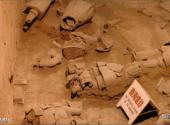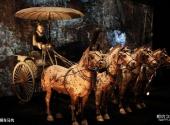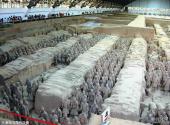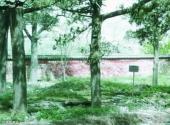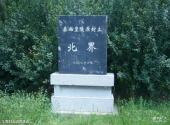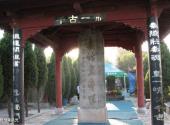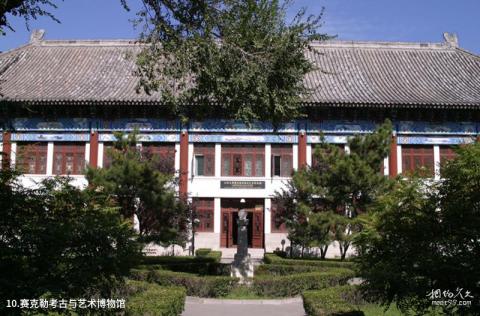
Scenic spot introduction:
The Mausoleum of the First Qin Emperor is the first large-scale and well-designed imperial mausoleum in Chinese history. It is also the largest underground imperial mausoleum in the world and one of the first batch of world cultural heritage in China. It is the mausoleum of the first emperor in Chinese history, Ying Zheng (259-210 BC). There are a large number of burial pits and tombs of different shapes and contents around the Mausoleum of the First Qin Emperor. More than 400 of them have been discovered, including the world-famous Terracotta Warriors and Horses Pit, the "Eighth Wonder of the World".The Mausoleum of Qin Shi Huang is located at the foot of Mount Li, east of Lintong County. It took 38 years to build. The huge scale and grandeur of the project set a precedent for the extravagant burials of feudal rulers in all dynasties. The tomb was discovered in 1974 surrounded by those famous pottery figurines, thus unveiling the mystery of this world-shocking wonder. The mausoleum is roughly in the shape of a Chinese character "回", with two inner and outer walls. The inner wall of the mausoleum has a circumference of 3,870 meters and the outer wall has a circumference of 6,210 meters. The large-scale ground buildings that have been discovered so far are the remains of the sleeping hall, the convenience hall, and the garden temple official residence.
The Mausoleum of Qin Shi Huangdi broke the tradition that people did not offer sacrifices to the ancestors in the tombs before the Qin Dynasty. For the first time, the sleeping hall for sacrifices was built in the tombs. The "sleeping room" was separated from the original ancestral temple and built on the side of the mausoleum. That is, there was a "court" (also known as a temple) when alive, and there should be a "court" after death. There was a "sleeping room" when alive, and there should be a "sleeping room" after death. This new system effectively influenced the imperial mausoleum system for the next two thousand years. The discovery of the mausoleum has also become an important factual basis for the study of history, art and culture, and is absolutely a priceless treasure.
Attractions distribution:
The Qin Shihuang Mausoleum Scenic Area covers an area of nearly 8 square kilometers, with the underground palace city (underground palace) as the core, and the others are the inner city, the outer city and outside the outer city. The main attractions include sealed earth mounds, drainage pipes, original sealed earth boundary ruins, and dormitory ruins and other buildings, and the unearthed cultural relics include the Shijia Pit, the Terracotta Warriors and Horses Pit, the Bronze Chariot and Horse Pit, etc.Scenic spot qualifications:
National 4A-level scenic spot, world cultural heritageScenic spot features:
Photography, Hiking, Sightseeing, Tombs, MuseumsScenic spot map:
travelling guideline:
The cemetery covers a vast area. Visitors can take electric cars and antique horse-drawn carriages to tour the cemetery, easily experience the beautiful environment of the Qin Mausoleum, witness the original site where the bronze chariot and horses were unearthed, and appreciate the bamboo slips wall of "Qin Shihuang's Chronicles" and the blue relief wall of "Qin Shihuang's Mausoleum Stories" beside the ring road.
Tour route:
Recommended one-day tour routes in Xi'an: Huaqing Hot Spring - Mausoleum of Qin Shihuang - Terracotta Warriors and Horses of Qin Shihuang.
Best time to visit:
Spring and autumn are the best time to travel every year, namely March to May when the spring is warm and the flowers are blooming, and September to November when the autumn is cool and the weather is cool. These are the best seasons to travel to Xi'an.
Shopping recommendations:
Cured beef, cured mutton, cured donkey meat, Xixiang beef jerky, Huanggui persimmon cake, Yan'an oil cake,臊子肉, oil-splashed chili, Qiongguotang, Sanyuan smoked chicken, spiced donkey meat, Qinchuan beef, Tongguan pickled bamboo shoots, apples, kiwis, Lintong pomegranates, Xifeng, Du Kang, Taibai, Qinchuan Daqu, Dingjun Mingmei, Lantian jade, imitation Qin terracotta warriors, imitation Tang tri-color glazed pottery, imitation bronze chariots and horses, etc.
Scenic spot map:
Scenic spot location:
China > Shaanxi Province > Xi'an > Lintong District
How to get there:
1. Take bus No. 5 (Route 306) or No. 914 or 915 at Xi'an Railway Station and get off at Qin Shi Huang Mausoleum Station. The whole journey is about 35 kilometers and takes about 1 hour.
2. Starting from Lintong District, you can take bus No. 914, 915, 101 and other special buses and get off at the Mausoleum of the First Qin Emperor. The whole journey is about 5 kilometers and takes about 15 minutes.
Scenic area map:
Click to expand the scenic area map
Qin Shi Huang Mausoleum Ticket Price:
Peak season (March 1 to November 31): 150 yuan
Off-season (12.1~2.28): 120 yuan
The scenic area provides more than 20 free services, including free tour guides, free umbrellas, free luggage storage, free introduction to the Qin Mausoleum, free photo rides in antique carriages, free 13 kinds of medicines for going out, free drinking mineral water, free cool towels, free use of telescopes, free stamping of the Qin Shihuang Mausoleum commemorative seal, etc.
Scenic area opening hours:
March 16 to November 14: 08:30 to 17:30
November 15th to March 15th: 08:30 to 17:00

